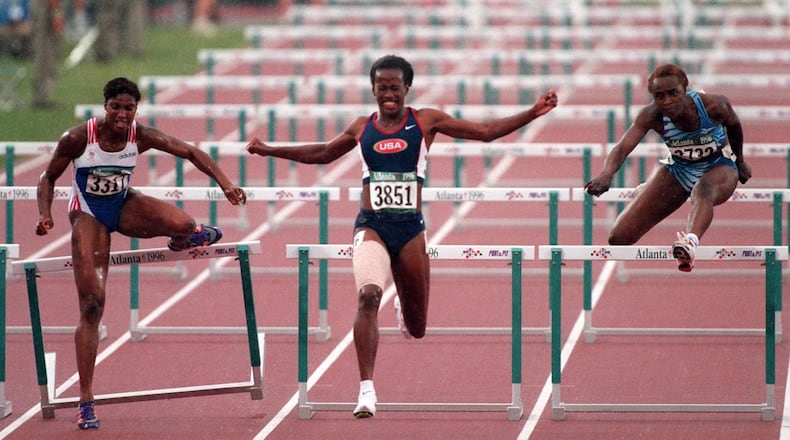In July and August 1996, the world sent its finest athletes to Atlanta. Some athletes came as familiar names from familiar nations. Others had toiled in obscurity. Each came proudly to Atlanta, and Atlanta received them in the same manner. To commemorate the 20th anniversary of those Summer Games, the AJC offers 20 memorable athletes and performances.
The fifth in the series: Jackie Joyner-Kersee overcomes injury to win a bronze medal.
Twenty years have passed since the 1996 Olympic Games, but for Jackie Joyner-Kersee, the pain from those games persists today.
But it’s not a physical pain. Joyner-Kersee’s anguish because of her right leg injury has long subsided. It’s a want for what could have been for the multi-event superstar in her fourth and final Olympics.
Joyner-Kersee entered the 1996 Summer Games having cemented herself in Olympics history. At 34 years old, she possessed three gold medals, with one silver and one bronze to boot. It was a resume that later led Sports Illustrated for Women to name her the Greatest Female Athlete of the 20th Century.
“My mindset was this was an Olympic Games again on American soil,” Joyner-Kersee said. “I wanted to have a great performance on American soil.”
Joyner-Kersee entered the games with a nagging hamstring in her right leg, reminiscent to the left leg issues she dealt with in the previous American Olympics, 12 years earlier in Los Angeles. Joyner-Kersee and husband and trainer Bob Kersee felt she could navigate the heptathlon and long jump as long as the leg was carefully monitored and cared for when she was not competing.
The first event of the heptathlon, the 100-meter hurdles, appeared to be the start of another special showing for Joyner-Kersee. She won the third heat while posting the second-fastest time among the 29 competitors in the event, setting herself up nicely with the high-jump event up next.
Looks, however, can be deceiving.
“As I went running the hurdles, I felt good at first, but in the middle of the race I felt my leg kind of grab,” Joyner-Kersee said. “I knew it was going to be a rough two days for me.”
With rainy conditions making matters worse, Joyner-Kersee went through a practice attempt on the high jump with lackluster results. Her leg began tightening as she stood and waited, dashing the hope that the injury could subside in the hour in between the first two events.
It was then Bob realized he couldn’t stand by idly anymore.
“As I’m walking back underneath a tent, I hear this whisper,” Joyner-Kersee said. “I’m like, ‘I know that’s not Bobby,’ because coaches aren’t allowed on the field. He said, ‘I’m going to pull you.’ I’m getting teary-eyed right now. He said, ‘Jackie, I know you’ll pull every muscle in your body out here, but you still have a shot at the long jump. You need to let that leg calm down.’”
Joyner-Kersee relented and rested for five days to compete in the long jump, but the wait seemed ineffective when the time arrived. She struggled through the first five rounds and found herself in sixth place with one attempt left.
With her Olympics career close to closing, Joyner-Kersee prepared herself to leave everything — her body included — on the line.
“I visualized myself coming down that runway, attacking the board, flying in the air and extending into that pit,” Joyner-Kersee said. “I said, ‘This is your last shot. If the leg goes, they’ll send a gurney out there, and they’ll pick me up and take me.’”
Her perseverance paid off. Joyner-Kersee pulled off a leap of 22 feet, 11 3/4 inches, good enough for third place.
“That bronze medal to me was just as great as winning the gold,” Joyner-Kersee said. “Everybody can do it when everything’s going according to plan.”
Twenty years later, Joyner-Kersee remains a busy woman.
She spends a lot of time giving motivational speeches across the country as well as teaching the elderly how to exercise properly. She dedicates the rest of her time to the Jackie Joyner-Kersee Foundation, which offers the youth in East St. Louis, Ill., a variety of programs to further their physical and intellectual education.
“I was breaking ground on the community center in ’96, and I remember this so clearly because that same day I pulled my hamstring getting ready for the Olympics,” Joyner-Kersee said.
Joyner-Kersee said she makes it a point to be a constant figure at the center and not just have her name on the outside of the building, which catches many attendees off-guard.
“Most of the kids are like, ‘Oh, I thought you’d be in Hollywood,’ Joyner-Kersee said. “I say, ‘Hollywood is right here.’”
Joyner-Kersee looked back on the bittersweet 1996 Olympics and keyed in on one aspect of the Games she carries with her today. As she prepared for the long jump, she was conscious of those in the crowd cheering for her to overcome the injury. She realized this moment involved more than herself, Bob and the rest of her team.
“People were there to support me and see a great performance,” Joyner-Kersee said. “There was so much love. That’s what I felt, and that’s what I’ll always remember about the games in Atlanta.”
About the Author


